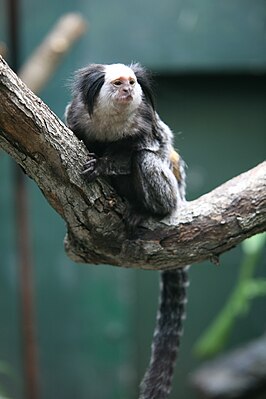Bald monkey
| Bald monkey | ||||||||||||
|---|---|---|---|---|---|---|---|---|---|---|---|---|

Bald marmoset ( Callithrix geoffroyi ) |
||||||||||||
| Systematics | ||||||||||||
|
||||||||||||
| Scientific name | ||||||||||||
| Callithrix geoffroyi | ||||||||||||
| ( Humboldt , 1812) |
The white-headed marmoset ( Callithrix geoffroyi ) is a species of primate in the marmoset family .
features
White-headed marmosets reach a body length of around 20 centimeters, with a tail that is around 29 centimeters long. The weight varies between 200 and 350 grams. Their fur is mostly dark gray to black, on the back it is speckled with orange-yellow hair, the tail is gray-white ringed. The white color of the head and throat is noticeable, the long ear tufts are dark gray to black. As with all marmosets, the fingers and toes (with the exception of the big toe) have claws instead of nails.
distribution and habitat
Bald marmosets are restricted to a small area in the Atlantic coastal forests of eastern Brazil . Their distribution area includes the southern Bahia , Espírito Santo and the eastern Minas Gerais .
Way of life
White-headed marmosets, like all marmosets, are active during the day; at night they sleep in tree hollows or in the liana thicket. They are tree dwellers, there they move on all fours or jumping.
They live in family groups with an average of eight to ten animals organized around a fully grown, reproductive pair. If there are several adult females in a group, one takes the dominant role. Groups inhabit territories of around 5 hectares in size. The territories can overlap and are usually not defended.
The food of the bald marmosets consists on the one hand of tree sap. Like all marmosets , thanks to their specialized teeth, they are able to gnaw holes in the tree bark to get to this source of food. They also eat fruits as well as insects and other small animals.
Reproduction
As with many marmosets, only the dominant female of the group reproduces, ovulation of the other animals is suppressed. Twins are usually born after a gestation period of 140 to 150 days. The father and the older siblings participate intensively in raising the young. The young are weaned after five to six months and reach sexual maturity in the second year.
threat
Bald marmosets inhabit a small area that is severely affected by deforestation. However, the species benefits from its adaptability and its ability to survive even in small, partially cleared forests. It is very common in certain areas and, in contrast to older assessments, is now listed by the IUCN as not at risk ( least concern ).
literature
- Thomas Geissmann : Comparative Primatology. Springer-Verlag, Berlin a. a. 2003, ISBN 3-540-43645-6 .
- Don E. Wilson, DeeAnn M. Reeder (Eds.): Mammal Species of the World. A taxonomic and geographic Reference. Johns Hopkins University Press, Baltimore MD 2005, ISBN 0-8018-8221-4 .
